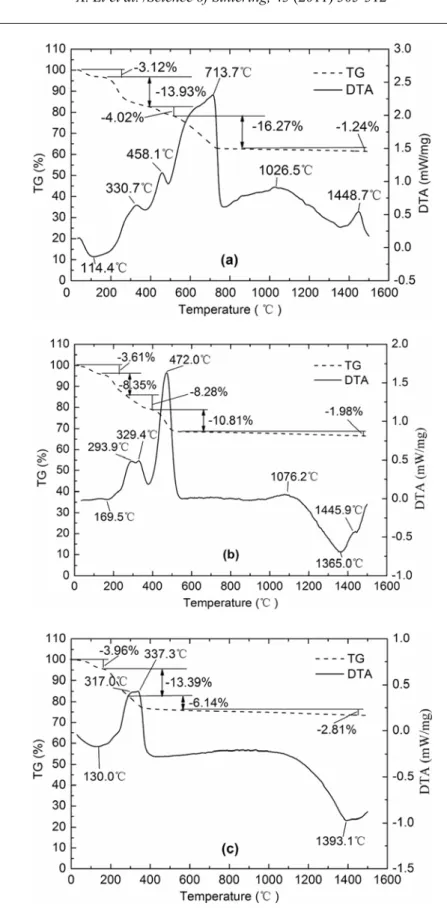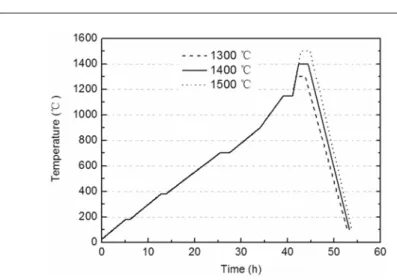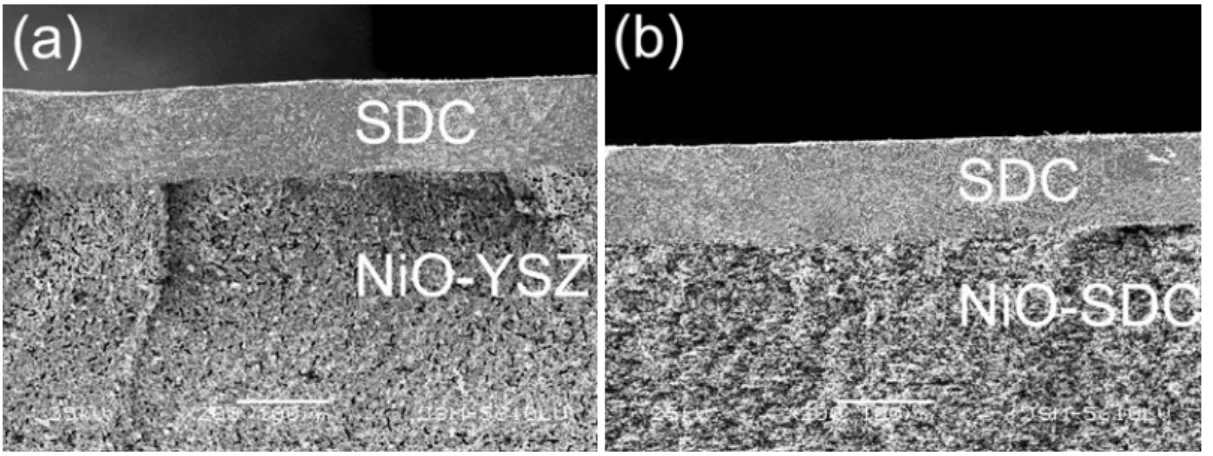_____________________________
*)Corresponding author: lixibao2007@yahoo.cn
doi:
10.2298/SOS1103305L
UDK 669.056.9
Effects of Laminating and Co-Firing Conditions on the
Performance of Anode-Supported Ce
0.8Sm
0.2O
1.9Film
Electrolyte
X. Li
1*
), J. Lu
1, H. Wang
21
School of Materials Science and Engineering, Nanchang Hangkong University,
Nanchang 330063, P. R. China
2
School of Mechanical and Electrical Engineering, Nanchang Institute of
Technology, Nanchang 330099, P. R. China
Abstract:
In order to evaluate the laminating and co-firing technique on the performance of anode-supported Ce0.8Sm0.2O1.9 (SDC) film electrolyte and its single cell, YSZ and NiO-SDC anode-supported NiO-SDC film electrolytes were fabricated by laminating 24 sheets of anode plus one sheet of electrolyte and co-firing. La0.4Sr0.6Co0.2Fe0.8O3-δ(LSCF)-SDC cathode was coated on the SDC electrolytes to form a single cell. The lamination was tried at different laminating temperatures and pressures and the co-firing was carried out at different temperatures. The results showed that the laminating temperature should above the glass transition temperature (Tg) of the binder. The laminating pressure of 70 MPa resulted in warp of the samples. The best co-firing temperature of the anode-supported SDC film electrolyte was 1400 oC. The SDC film electrolyte formed well adherence to the anode. The NiO-YSZ anode had larger flexural strength than the NiO-SDC anode. The NiO-YSZ anode-supported SDC film electrolyte single cell had an open circuit voltage of 0.803 V and a maximum power density of 93.03 mW/cm2 with hydrogen as fuel at 800 oC.
Keywords: Ce0.8Sm0.2O1.9, Laminating, Co-firing, Condition, Anode-supported SOFC
1. Introduction
Solid oxide fuel cell (SOFC) is an electrochemical device that can convert chemical energy to electrical energy directly. Reducing the operating temperature of SOFC to intermediate temperature or even lower temperature can bring many advantages such as faster starting time, lower cost, more matching of thermal expansion and so on, which becomes the main research objective and hotspot of SOFC in recent years [1-3]. Anode-supported thin film electrolyte is an attractive choice for SOFC because the thickness of electrolyte can be reduced to less than 100 μm, which conduces to reduce the operating temperature of SOFC.
Moon et al [7] studied the tape casting and co-firing conditions for anode-supported YSZ electrolyte fabricated by tape casting and co-firing techniques. Park et al [8] investigated the effects of laminating direction and various loads value for co-firing on the flatness of NiO-YSZ anode-supported NiO-YSZ thin electrolyte. However, few reports were concerned with the effects of laminating and co-firing conditions on the performance of anode-supported Ce0.8Sm0.2O1.9 (SDC) film electrolyte.
The present work aims to evaluate the laminating and co-firing technique on the performance of anode-supported film SDC electrolyte and its single cell. The effects of laminating temperature, laminating pressure and co-firing temperature on the performance of anode-supported SDC film electrolyte are investigated. The properties of the NiO-YSZ and NiO-SDC anodes are compared. The discharge performance of NiO-YSZ anode-supported SDC film electrolyte single cell is also studied.
2. Experimental procedure
Commercial powder of NiO (Sinopharm Chemical Reagent Co. Ltd, China), SDC powder prepared by spray pyrolysis [9], YSZ and La0.4Sr0.6Co0.2Fe0.8O3-δ (LSCF) powders
prepared by coprecipitation [10] and carbon black (Sinopharm Chemical Reagent Co. Ltd, China) were used as raw materials to prepare the NiO-YSZ (6:4, wt.%) anode, the NiO-SDC (6:4, wt.%) anode, and the SDC electrolyte. The green tapes of NiO-YSZ anode, NiO-SDC anode and SDC electrolyte were prepared by aqueous tape casting [11]. NiO-YSZ anode-supported SDC film electrolyte and NiO-SDC anode-anode-supported SDC film electrolyte were fabricated by laminating 24 sheets of anode plus one sheet of electrolyte and co-firing. The single cell was fabricated after LSCF-SDC (1:1, wt.%) cathode was coated on SDC electrolyte and sintered.
The TG/DTA test of green tapes was carried out in air from room temperature to 1500 oC with a heating rate of 10 oC/min by synchronous thermal analyzer (STA449c/3/G, Netzsch Co., Germany). The open porosity of sintered anodes and electrolyte was measured by Archimedes method. The flexural strength of sintered anodes was determined by modified small punch test (MSP) method [12, 13]. The performance of single cell was measured from 500 oC to 800 oC with air as oxidizing agent and hydrogen gas as fuel. The microstructure was characterized by scanning electron microscope (JSM-5610LV, JEOL Ltd., Japan).
3. Results and discussion
3.1. Effect of laminating temperature on the performance of anode-supported
electrolyte
Circular shape sheets were punched from the green tapes. 24 sheets of anode plus one sheet of electrolyte were stacked and laminated at different pressures and temperatures. In order to investigate the effects of laminating conditions on the performance of anode-supported electrolyte, three different temperatures (55, 75 and 95oC) were tested. The laminating temperatures were chosen to be around the glass transition temperature (Tg) of
PVA which was as the binder of the green tapes. The Tg of PVA was usually 75 - 85 oC. After
warm pressed, delamination existed in the sample laminated at 55 oC and the samples laminated at 75 oC and 95 oC were good and had no obvious differences. This showed that the laminating temperature should be at least above the Tg of PVA. The reason might be that the
3.2 Effect of laminating pressure on the performance of anode-supported
electrolyte
Three different pressures (30, 50 and 70 MPa) were tested to investigate the effect of laminating pressure on the performance of anode-supported electrolyte. After laminated at 75oC and three different pressures (30, 50 and 70 MPa) for 20 min, the samples were binder burnt-out and co-fired at 1400 oC for 2 h. Fig. 1 was the anode-supported SDC electrolyte that burnt-out and co-fired at the same condition but laminated at different pressures. It could be seen that the sample that laminated at 70 MPa was warped but the samples laminated at 30 MP and 50 MP were flat. The reason for this was unclear but might be a result of the higher residual stress in the sample that laminated at 70 MPa.
Fig. 1. Anode-supported SDC electrolyte laminated at different pressures
3.3. Effect of co-firing condition on the performance of anode-supported
electrolyte
In order to investigate the reaction of the laminated green samples during co-firing, TG/DTA tests were carried out in air from room temperature to 1500 oC. Fig. 2 was the TG/DTA curves of laminated samples of NiO-YSZ anode-supported SDC electrolyte (abbreviated as NiO-YSZ/SDC), NiO-SDC anode-supported SDC electrolyte (abbreviated as NiO-SDC/SDC) and SDC electrolyte (abbreviated as SDC). It could be seen that organic matters were decomposed and oxidized before 750 oC. Carbon black was oxidized and burnt before 1150oC. The endothermic peaks at 1365.9 oC and 1393.1 oC were probably due to the decomposition of CeO2 that had not completely dissolved into SDC. The exothermic peaks at
1448.7oC and 1445.9 oC indicated that there were some compounds forming around these temperatures. A small quantity of compound such as CexZr1-xO2 (X=0.2-0.8) [14, 15] might
be formed from SDC and YSZ in the mixture, which led to the exothermic reaction around 1450oC.
Fig. 2. TG/DTA curves of laminated samples (a) NiO-YSZ/SDC, (b) NiO-SDC/SDC,
Fig. 3. Binder burn-out and co-firing process of anode-supported SDC electrolyte
Fig. 4. Open porosity of sintered anodes and electrolyte
3.4. Characterization of sintered samples
As the supporter of SOFC, the mechanical strength of anodes should achieve the desired reliability. In published papers, the flexural strength of NiO-YSZ anode was 95.4 MPa [16] and 123 MPa [17], the flexural strength of NiO-SDC anode was 137 MPa [18]. About 100 MPa was generally as the basic requirement of the strength for anode-supported SOFC [16-18]. In this study, the flexural strength of sintered NiO-SDC and NiO-YSZ anode was about 65.6 MPa and 165.6 MPa, respectively, which was shown in Fig. 5. These indicated that the strength of as-fabricated NiO-YSZ anode was more suitable for anode-supported SDC film electrolyte.
porous and homogeneous anodes. These illustrated that the laminated and co-fired samples had good microstructure on which the SDC film electrolytes were supported by laminated anodes.
Fig. 5. Flexural strength of sintered anodes
Fig. 6. SEM of cross section of anode-supported SDC film electrolyte
The I-V and I-P characteristics of the NiO-YSZ anode-supported SDC electrolyte single cell were shown in Fig. 7. The almost linear I-V curve indicated little electrode polarization. The open circuit voltage (OCV) was 0.803 V at 800 oC, which was very close to the theoretical value of 0.818 V. The maximum power density of anode-supported SDC electrolyte single cell was 93.03 mW/cm2 with hydrogen as fuel at 800 oC. These results illustrated that an anode-supported SDC film electrolyte single cell was successfully fabricated by laminating and co-firing technique.
4. Conclusions
The NiO-YSZ and NiO-SDC anode-supported SDC film electrolytes were fabricated by laminating 24 sheets of anode plus one sheet of electrolyte and co-firing. Through laminating at different temperatures that around the Tg of the binder and pressures from 30
MPa to 70 MPa, it was found that the laminated sample was delaminated below the Tg of the
binder, and the samples that laminated above the Tg were good. After co-fired, the sample that
laminated at 70 MPa was warped but the ones laminated at 30 MPa and 50 MP were flat. Too high laminating pressure resulted in high residual stress in the samples. According to the TG/DTA analysis of green tapes and the open porosity of anodes and electrolyte that sintered at 1300, 1400 and 1500 oC, the best co-firing temperature was chosen to be 1400 oC. After co-fired at 1400 oC, the flexural strength of sintered NiO-SDC and NiO-YSZ anode was about 65.6 MPa and 165.6 MPa, respectively. The NiO-YSZ anode was more suitable for anode-supported SDC film electrolyte, although both NiO-SDC and NiO-YSZ anode-anode-supported SDC film electrolytes presented pretty microstructure. The single cell was fabricated after LSCF-SDC cathode was coated on the NiO-YSZ anode-supported SDC film electrolyte. The open circuit voltage of the single cell was 0.803 V at 800 oC, which was very close to the theoretical value. The maximum power density of the anode-supported SDC electrolyte single cell was 93.03 mW/cm2 with hydrogen as fuel at 800 oC. An anode-supported SDC film electrolyte single cell was successfully fabricated by laminating and co-firing technique.
Acknowledgements
The authors acknowledge the financial support from Research Foundation for Doctors of Nanchang Hangkong University (Grant No. EA201001197).
References
1. K. Xie, J. E. Zhou, G. Y. Meng, J. Alloy. Compd., 506 (2010) 8.
2. S. K. Lee, J. M. Kim, H. S. Hong, et al, J. Alloy. Compd., 467 (2009) 614. 3. G. Laukaitis, J. Dudonis, J. Alloy. Compd., 459 (2008) 321.
4. E. Ozel, S. Kurama, J. Mater. Process. Tech., 198 (2008) 69.
5. L. H. Luo, A. I. Y. Tok, F. Y. C. Boey, Mat. Sci. Eng. A-Struct., 429 (2006) 267. 6. S. B. Savignat, M. Chiron, C. Barthet, J. Eur. Ceram. Soc., 27 (2007) 674. 7. H. Moon, S. D. Kim, S. H. Hyun, et al, Int. J. Hydrogen Energ., 33 (2008) 1759. 8. H. Park, H. Moon, S. C. Park, et al, J. Power Sources, 195 (2010) 2465.
9. X. B. Li, G. Q. Shao, X. H. Yu, et al, J. Mater. Sci. - Mater. El., 22 (2011) 189. 10. S. B. Chen, S. F. Wang, L. Li, J. Ceram., 31 (2010) 262.
14. J. R. Gonzalez-velasco, M. A. Gutierrez-oritiz, J. L. Marc, Appl. Catal. B-Environ., 22 (1999) 168.
15. C. E. Hori, H. Permana, K. Y. Simon, et al, Appl. Catal. B-Environ., 16 (1998) 105. 16. M. Radovic, E. Lara-Curzio, Acta Mater., 52 (2004) 5748.
17. Y. S. Xie, X. E. Zhang, M. Robertson, et al, Mater. Sci. Forum, 539-543 (2007) 1421. 18. M. Chen, B. H. Kim, Q. Xu, et al, J. Eur. Ceram. Soc., 28 (2008) 2947.
Са р а:



